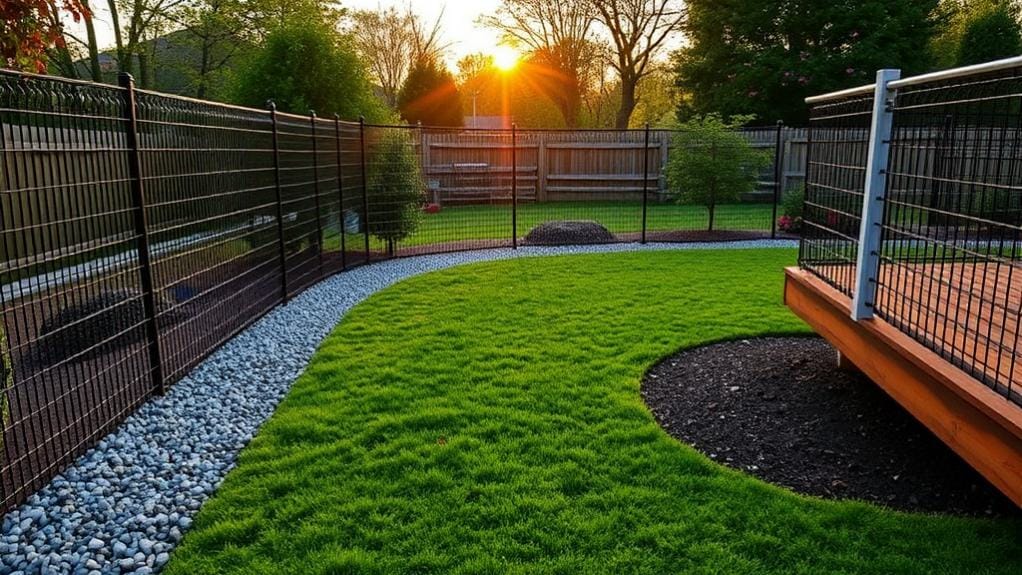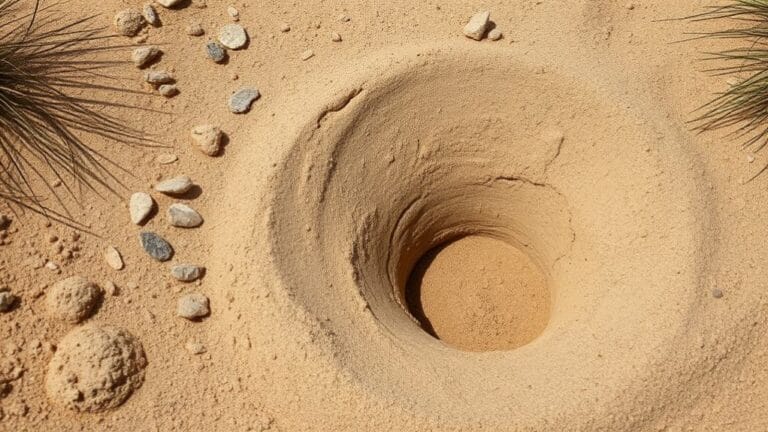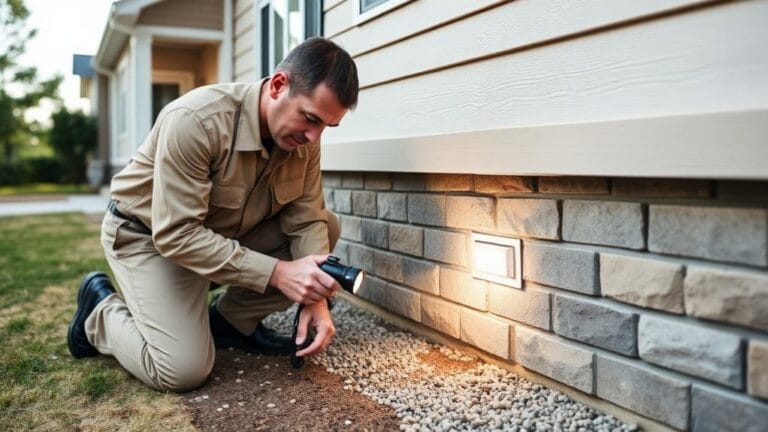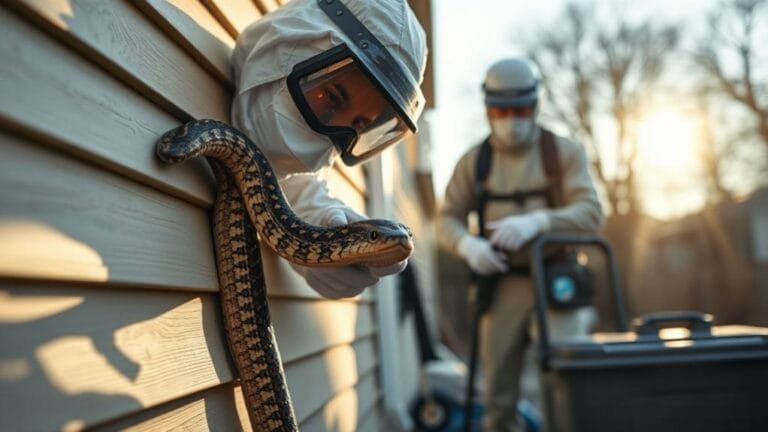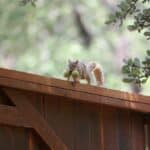Want to keep slithering visitors out of your yard? I've got your back with a weekend snake-proofing plan that actually works. Start by clearing ALL debris and keeping grass under 3 inches – snakes hate feeling exposed. Install quarter-inch mesh fencing buried a few inches deep, create sharp gravel barriers, and seal every crack in your home's foundation. Remove standing water, secure pet food indoors, and position bird feeders far from your house. Most importantly, eliminate those rodents – they're basically rolling out the snake welcome mat. But that's just scratching the surface of snake-proofing success.
Clear Yard Debris and Clutter
Table of Contents
Anyone seeking to snake-proof their yard must start by removing potential hiding spots. I'm talking about those leaf piles you've been ignoring and those old branches you swear you'll deal with "someday." Well, guess what? Snakes love that mess.
Natural pest control starts with maintaining a clean yard, which also encourages beneficial predators like cats and dogs to patrol your property.
Let's get serious about clearing your space:
- Tackle those large rocks and debris first – they're perfect snake condos
- Remove discarded plywood and broken furniture that shelter rodents (and yeah, those rodents attract snakes)
- Store firewood and lumber off the ground – no snake basement apartments allowed
Pro Tip: Make routine clean-ups your new weekend hobby. Trust me, it's better than finding a surprise snake sunbathing on your patio.
Keep your yard clutter-free and organized. When outdoor items accumulate, you're basically running a snake bed & breakfast.
Trim Grass and Control Weeds
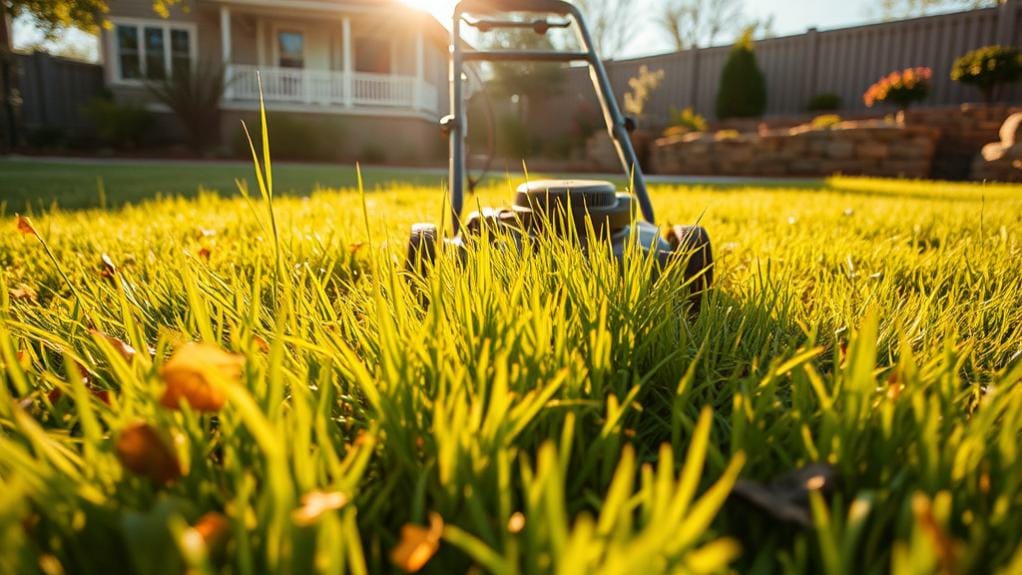
Beyond clearing debris, your grass maintenance plays a key role in keeping snakes at bay. I'll be blunt – if you're letting your grass grow like an abandoned golf course, you're basically rolling out the welcome mat for serpentine squatters. Keep that grass under 3 inches and you'll drastically reduce hiding spots while increasing visibility of snakes.
| Action | Purpose | Impact |
|---|---|---|
| Trim grass weekly | Maintain low height | Reduces cover |
| Control weeds | Prevent overgrowth | Limits nesting areas |
| Remove thick grass | Increase visibility | Exposes to predators |
| Add decorative stone | Replace grass areas | Deters habitation |
*Pro Tip: A well-manicured yard isn't just for impressing the neighbors – it's your first line of defense against unwanted slithering guests. Consider snake-proof fencing as an extra measure if you're really serious about this.*
Secure Pet Food Storage
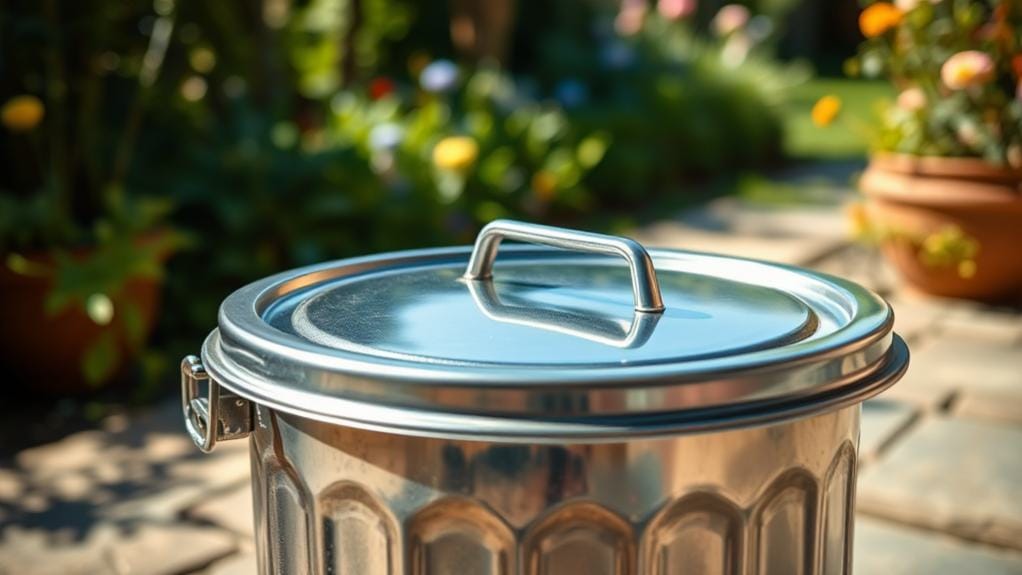
Looking after your pet's food storage is essential for keeping snakes off your property.
Let's be honest – if you're leaving pet food scattered around your yard, you might as well put up a "Snake Buffet" sign. Since snakes are attracted to rodent populations, eliminating easy food access is vital for prevention.
Secure pet food storage isn't just about being tidy – it's about survival.
Here's what you need to do:
- Store all pet food in tightly sealed containers (metal ones are your best friend)
- Move feeding time indoors (your pets won't mind, trust me)
- Clean up uneaten pet food immediately (yes, even those tiny bits)
Pro Tip: Use feeding mats to catch food debris – they're easier to clean than picking up scattered kibble from your lawn.
Remember: Every bit of pet food left outside is basically sending an invitation to rodents, who then attract snakes.
Don't be that neighbor who accidentally creates a wildlife restaurant.
Install Snake-Proof Fencing
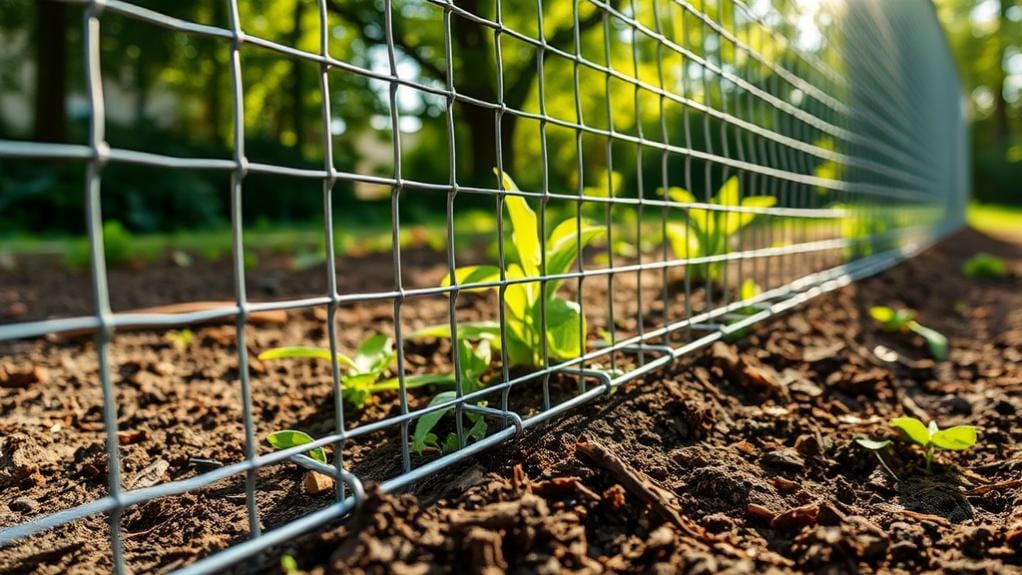
A solid snake-proof fence forms your yard's first line of defense against unwanted serpentine visitors. When installing snake-proof fencing, you'll want to use 1/4 inch or smaller rigid mesh that stands 3-4 feet high.
Amagabeli hardware cloth offers excellent durability with a 7+ year lifespan and galvanized construction. I recommend galvanized or stainless steel materials – because nobody wants to replace this bad boy every couple years.
- Want to sleep better at night? Make sure you bury that fence a few inches deep to prevent snakes from burrowing underneath. Those sneaky rascals are persistent!
- Think you're done? Not so fast! Add a bent overhang at the top to create an additional barrier against climbing snakes.
- Here's the deal-breaker: regularly inspect the fencing for damage or gaps. Even tiny holes can turn your fortress into Swiss cheese.
Pro Tip: *Don't skimp on materials – this is one project where cutting corners can literally come back to bite you.*
Manage Water Sources
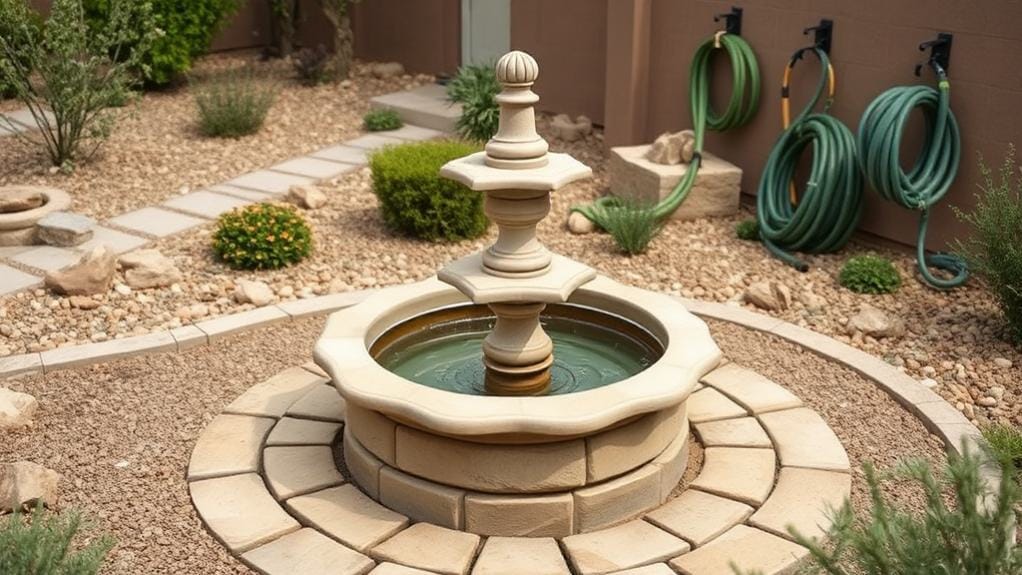
While snake-proof fencing keeps the reptiles out, managing water sources in your yard determines whether they want to visit in the first place.
I'll be blunt – if you've got standing water anywhere, you're basically running a snake bed & breakfast.
Eastern coral snakes and other venomous species are particularly drawn to moist environments, making water management essential for safety.
Start with these essential fixes:
- Clean those gutters! Direct water away from your foundation or you'll create a snake superhighway.
- Cover your pool at night (unless you enjoy midnight snake swimming).
- Fix leaky faucets immediately – that constant drip is like a "snakes welcome" sign.
- Remove birdbaths and decorative ponds, or you're basically advertising free snake refreshments.
Pro Tip: A tidy yard with zero stagnant water means fewer rodents hanging around. No rodents = no snakes. It's that simple.
Remember: Moisture attracts snakes and their prey.
Don't make your yard their favorite hangout spot.
Remove Rodent Attractions
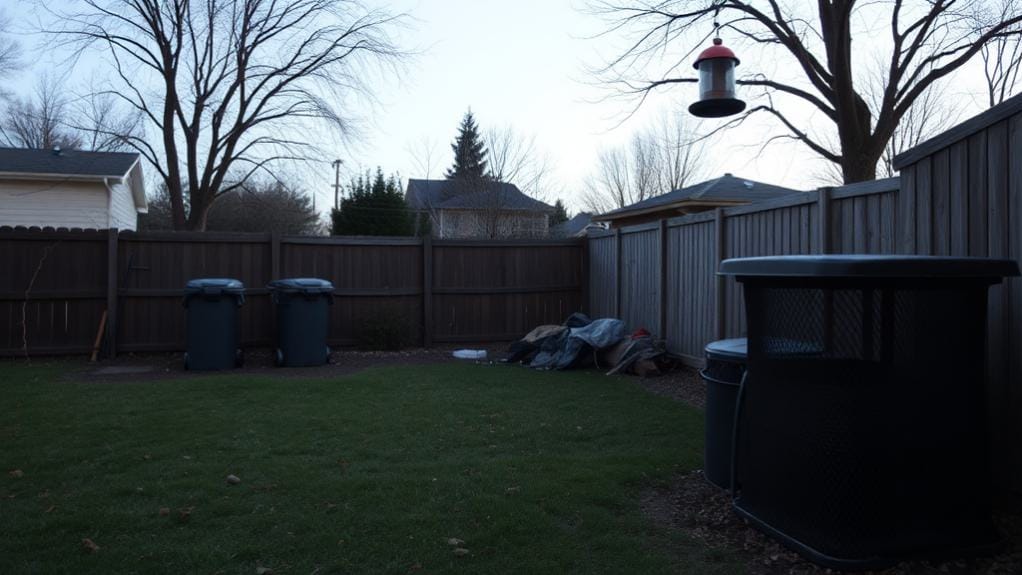
Rodents roll out the welcome mat for snakes in your yard, and I've seen how quickly this problem can spiral. Just like motion-activated devices help deter unwanted wildlife, maintaining a rodent-free space is essential for snake prevention.
Let's get real – if you're feeding the rats, you're basically sending snakes an engraved dinner invitation. Maintaining cleanliness in your yard isn't just about looks – it's about survival.
To remove rodent attractions and eliminate food sources that bring unwanted serpentine visitors, you'll need to get serious about rodent control measures. Keep those trash bins and compost piles sealed tight.
And please, for everyone's sake, stop turning your yard into a rodent resort.
- Your outdoor pet food buffet? Yeah, that's basically a snake's DoorDash
- Those messy bird feeders dropping spilled seeds everywhere? Rodent paradise
- That pile of debris you've been meaning to clear? It's now a five-star rodent hotel
Seal Building Entry Points
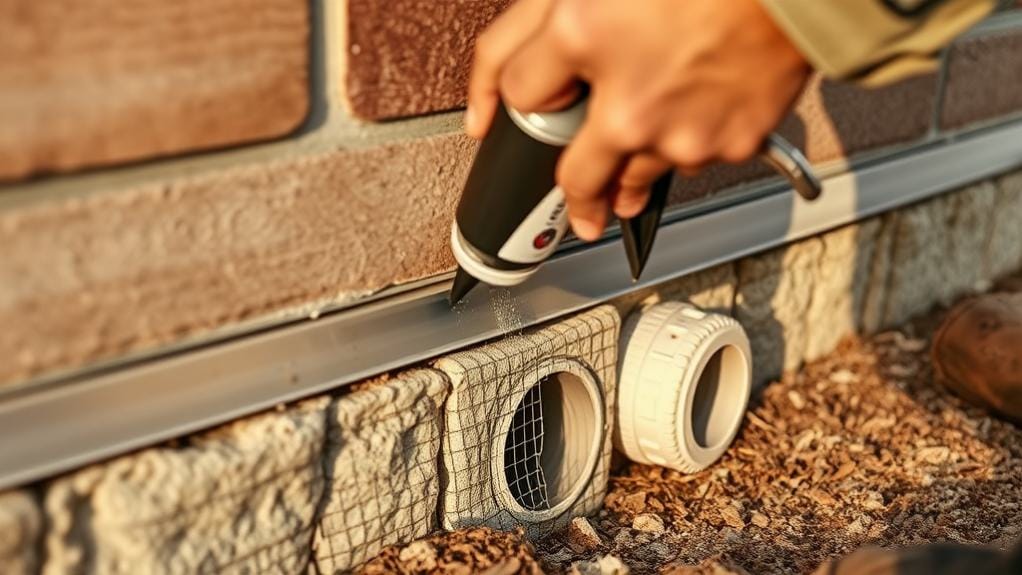
Every crack and gap in your home's exterior is an open invitation for snakes seeking shelter.
I've seen countless homeowners learn this lesson the hard way. Trust me – you don't want a surprise serpent roommate. Snakes are particularly drawn to warm pipe areas near water heaters and plumbing fixtures, making thorough inspection essential.
Let's seal those entry points right now:
- Check your foundations, windows, and doors for cracks and crevices – yes, even those tiny ones you think are "too small" for snakes
- Use caulk for smaller gaps (snakes are basically liquid when they want to be)
- Install hardware cloth over larger openings – and don't cheap out on this part
- Repair damaged vent screens immediately
*Pro Tip: Do a seasonal inspection of your home's exterior. Weather changes make snakes extra motivated to find cozy indoor spots.
And while you're at it, get an energy audit – it'll help spot vulnerabilities you might miss.*
Create Gravel Border Barriers

Strategically placed gravel borders serve as one of your strongest defenses against unwanted snake visitors. I'm talking about a solid 2-3 foot wide barrier that'll make those slithery neighbors think twice before crossing.
Trust me – snakes hate scrambling over sharp gravel edges almost as much as I hate finding them in my garden.
- Say goodbye to those perfect snake hide spots you've accidentally created with your overgrown ground cover
- Watch those sneaky serpents decide your yard isn't worth the hassle anymore
- Feel confident letting your kids and pets play outside without constant snake paranoia
Pro tip: Don't get lazy with maintenance! Regular raking and debris removal are essential.
Combine your gravel border with trimmed vegetation and proper landscaping. Your snake-proofing efforts are only as good as your upkeep, so stay on top of it. No excuses!
Position Bird Feeders Strategically
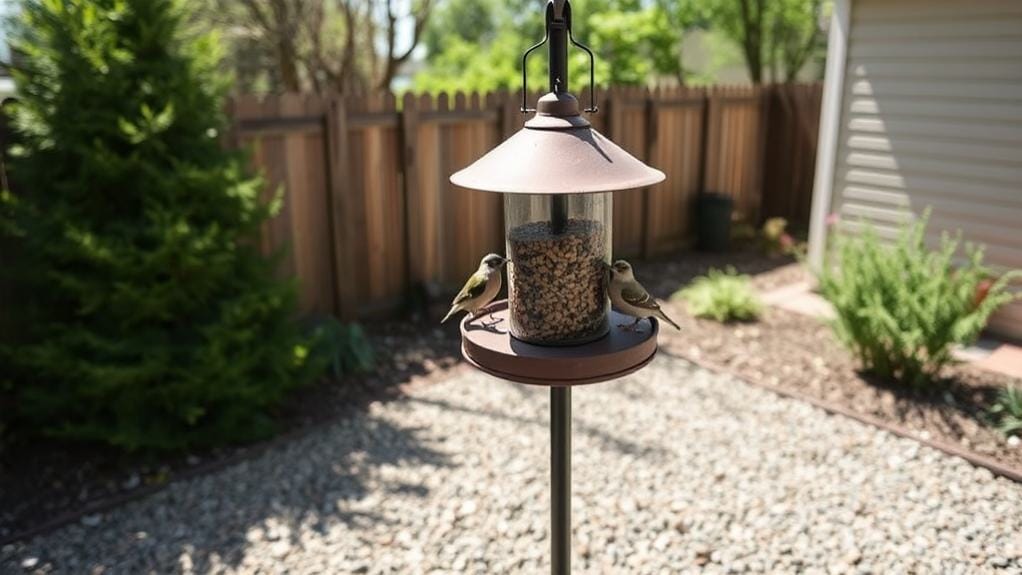
One of the biggest mistakes homeowners make is placing bird feeders too close to their homes. If you're wondering why snakes keep showing up in your yard, those bird feeders might be your answer. Let me break this down for you.
| Bird Feeder Dos | Bird Feeder Don'ts |
|---|---|
| Position 20+ feet from house | Place near windows |
| Use metal feeders | Use plastic feeders |
| Install squirrel-proof designs | Leave seed scattered |
| Clean up daily | Ignore fallen seeds |
| Use tight-fitting lids | Overfill feeders |
I know you love watching birds from your kitchen window, but trust me – having a snake visit while you're sipping morning coffee isn't fun. Position bird feeders strategically to reduce likelihood of attracting rodents. These little critters become food sources that attracts snakes. Snake prevention starts with smart placement and regular maintenance. Use metal bird feeders and clean up fallen seeds daily. Your feathered friends will still visit, and you'll have fewer slithering guests.
Maintain Garden Ground Cover
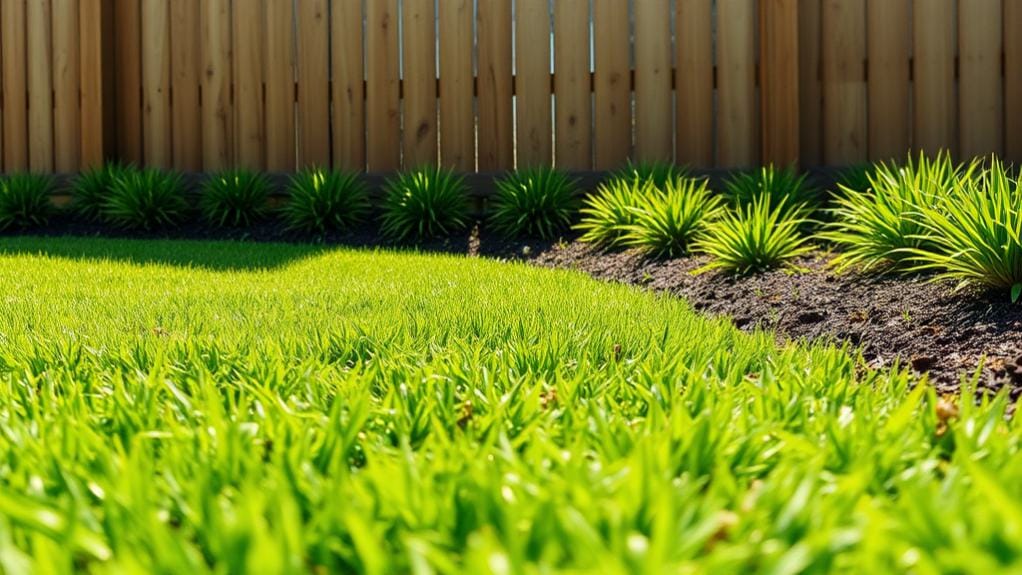
Ground cover management plays an essential role in deterring snakes from your yard. I'll tell you straight up – if you're letting your garden become a snake's paradise, you're doing it wrong.
Reduce potential hiding spots for snakes by limiting ground cover plants like ivy to specific zones. And please, avoid using thick mulch layers over 6 inches unless you're trying to host a snake convention.
- Your garden isn't a jungle – regularly trim bushes and shrubs to maintain visibility.
- Keep that grass short by mowing regularly (snakes hate feeling exposed).
- Skip the dense vegetation and opt for gravel or hardscaping to create a less inviting habitat for snakes.
Pro tip: *Create open areas throughout your garden by strategically placing hardscape elements. Trust me, snakes prefer to slither elsewhere when they can't find cozy hiding spots.*
Frequently Asked Questions
What Do You Put in Your Yard to Keep Snakes Away?
I recommend using cedar, cinnamon, or clove essential oils around your yard's perimeter. I'd also remove debris, keep grass short, and install fine mesh fencing to effectively keep snakes away from your property.
What Will Snakes Not Crawl Over?
Hey, I'm no snake whisperer, but I'll tell you – snakes won't slither across rough gravel, abrasive surfaces, or prickly plants. They also hate crossing wide stretches of dry sand and properly installed mesh fencing.
How to Make Your Yard Snake Free?
I recommend keeping your grass short, removing debris piles, sealing foundation gaps, eliminating rodent food sources, and maintaining trimmed bushes. These steps won't guarantee a snake-free yard, but they'll greatly reduce encounters.
What Do Snakes Hate the Most?
Like a nose-pinching whiff of ammonia, I'll tell you snakes hate strong scents the most. I've found they're especially repelled by clove oil, cinnamon, sulfur, and garlic-onion mixtures that irritate their senses.
Last Word
Let's face it – snakes aren't going to slither away on their own. But you're not up a creek without a paddle anymore. I've given you practical steps to make your yard less appealing to these unwanted visitors. Take action this weekend using these snake-proofing techniques. Remember: prevention beats panic every time. While you can't guarantee a completely snake-free yard, you'll sleep better knowing you've made your property as unwelcoming as possible to these reptilian guests.

